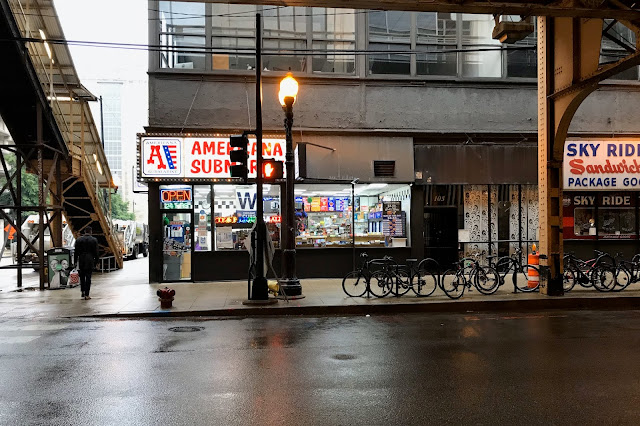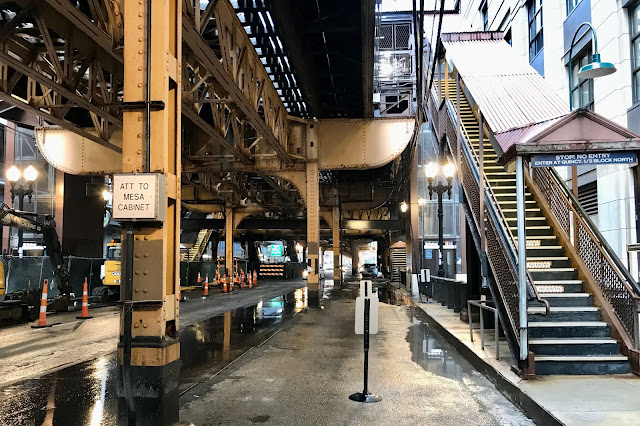The Chicago Loop is a unique transport solution. Transit lines from all points of the city converge on a central elevated loop, entering and circulating until they spool off in another direction to complete their journeys. Underneath the elevated railway is a zone of semi-darkness where a shadow is cast on traffic and trade. An elevated railway was an attractive option for transport planners working to a budget - the cost per mile is a fraction of the cost of constructing underground. Road networks of broad and straight boulevards encouraged American city planners to adopt this solution and Boston, Philadelphia and New York City still have significant sections of elevated tracks although only Chicago operates them in the central business district. In other cities they have retreated to the suburbs.
Artists and photographers were quick to spot the novel visual drama of a railway that passed over the street and recorded the scene with fascination. Visual Telling of Stories has a concise summary of the appeal. But for those existing at ground level it produced a degraded environment in which the roar of the traffic was amplified by the overhead structures, to which was added the percussive rumble of passing trains. Intensified by the lack of daylight, mounting hostility to elevated railways from property owners and business interests forced them out of Manhattan by 1955 but in Chicago they persisted. Sections of elevated railway are common in Berlin and Hamburg, while in Paris, lines 2 and 6 of the Métro run overhead for significant parts of their journeys. Somehow none of these systems has anything like the impact on its surroundings as the Chicago “L”. The reason for this may lie in the constrained character of the Loop that serves to concentrate and magnify its effects. In other cities, many routes follow central reservations, a mitigation unavailable in Chicago.
To this visiting observer all this is very fascinating and it’s an easy matter to walk the entire circuit and appreciate how it impacts on its surroundings while enjoying the brutal and unadorned heavy metal structures that keep all that stuff up in the air where it belongs. Where the streets are broad it sails overhead with little disturbance, the sidewalks being open to the elements. It’s a much more intrusive presence in narrower streets where our field of vision is greatly restricted and there’s an obvious decline in business where this happens. Prestige retail happily thrives on the wider avenues while more marginal retail dominates as the streets get narrower and feel like caged spaces. In essence, the system was developed in accordance with the prevailing American infrastructure aesthetic where every dollar must be worked to the utmost using hard materials, military quality build, with a scrupulous avoidance of any extraneous design elements that might make it easy on the eye. If American transit had been designed to the same standard as the Detroit auto industry in its mid century glory, it would be the wonder of the world for its extravagance and futuristic embellishment.
The disruptive dazzle of sunlight spattering on the streets below is much favoured by photographers but I found more of interest to record after nightfall and in the rain when halogen and LED lights are reflected off hard surfaces. Busy thoroughfares empty out at nights to express a sense of desolation and urban melancholy. This selection of photographs taken last June are not intended as a photo-essay - just a series of images inspired by a strange and forbidding urban structure.






































